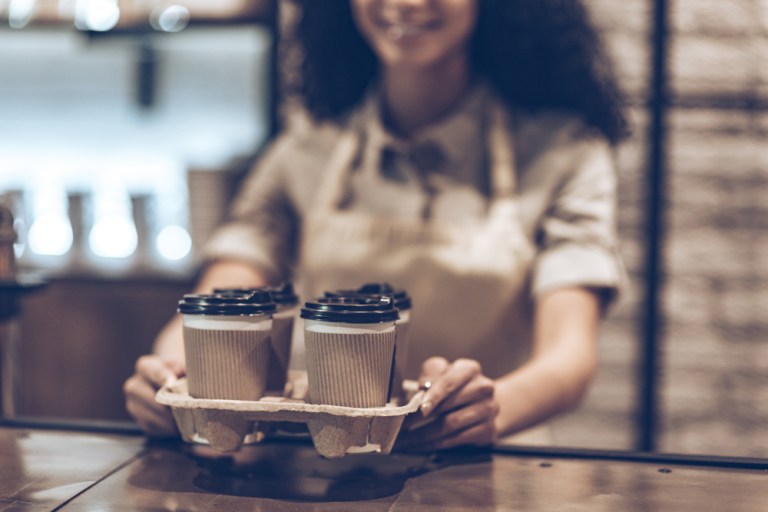
Dunkin’ Donuts wants to take more control over its mobile payments.
That’s the thinking behind a deal announced on July 26 with mobile wallet provider CARDFREE that gives the chain a “perpetual license to the software used to build and operate the (Dunkin’) mobile ordering and payment platform.”
Or, as Dunkin’ Brands CEO David Hoffman put it during the company’s Q2 post-earnings conference call: “Our agreement with CARDFREE enables us to control our own destiny with the DD mobile app and to accelerate important digital initiatives, such as one-to-one marketing, catering, delivery and group ordering, just to name a few.”
The deal represents the latest move in the never-ending competition between Dunkin’ Donuts and Starbucks to please coffee-loving consumers who love their mobile phones. Both companies have released their latest financials, and those reports, along with associated comments from executives, provide an update of that mobile payments battle, and signs of what might follow.
Starbucks Lead
Starbucks has a comfortable advantage, given that it remains the most popular proximity mobile payment app, according to a May report from eMarketer.
“This year, 23.4 million people ages 14 and over will use the Starbucks app to make a point-of-sale purchase at least once every six months,” it said. “That puts it slightly ahead of the 22.0 million people who will use Apple Pay. Google Pay (11.1 million users) and Samsung Pay (9.9 million) will round out the top four payment apps. The ranking will remain unchanged through 2022.”
That doesn’t mean Starbucks has nothing to worry about when it comes to mobile payments. The eMarketer report said that while those four biggest apps will continue to gain U.S. users through 2022, “their share of mobile payment users will continue to drop. That can mainly be attributed to new payment apps entering the market, particularly merchant-branded mobile apps.”
Dunkin’ Moves
Dunkin’ Donuts is certainly hoping so.
Its mobile ordering app is exclusive to members of the company’s loyalty program, which added two million members in 2017, and now has about eight million. Those loyalty members can use the chain’s On-the-Go Mobile Ordering service, which enables such tasks as re-ordering favorite products, customization of drinks, menu browsing and quick in-store pickup of purchases.
Dunkin’ said that 80 percent of consumers who try On-the-Go Mobile Ordering use it at least once more.
Potential new features for the Dunkin’ mobile payments and ordering offering include the automatic sending of orders tied to a particular time (for instance, when a consumer leaves the subway) and one-click ordering, in which customers could open the app and hit one button on their home screen to place a recent order.
During the second half of this year, in another effort to boost loyalty program and mobile payment participation, the chain will operate its “tender agnostic” test. The chain wants to enable its loyalty program members to “earn points using all forms of tender, including their DD card, credit, debit or cash. The company expects that being tender agnostic will allow it to better connect and serve a wider audience of its most loyal guests.”
Starbucks Plans
For its part, Starbucks, during its fiscal Q3 financial results, reported ongoing success with its own Mobile Order and Pay service, which the company recently opened up to consumers who are not part of the chain’s loyalty program.
Those Mobile Order and Pay transactions now make up 13 percent of U.S. company-operated transactions, the company said in its financial report. That compares with 12 percent for the company’s fiscal Q2. In the fiscal third quarter of 2017, Mobile Order and Pay accounted for 9 percent of those transactions.
The chain offered no detailed figures about mobile payments beyond those Order and Pay figures, but at the end of 2017, mobile payments accounted for 30 percent of the brand’s total transactions.
The Starbucks Rewards loyalty program has 15.1 million active members — including 1.9 million added during fiscal Q3 — and they accounted for 40 percent of sales at company-operated stores. That’s up from 36 percent in fiscal Q3 2017.
Next spring, Starbucks intends to enhance the appeal of its loyalty program — which in turn could drive more mobile payments — by enabling members “to redeem different amounts of stars for different products, giving them a choice to use stars sooner for lower-ticket items or save for higher-ticket items like lunch, packaged coffee and merchandise,” said Rosalind Brewer, Starbucks chief operating officer, during the company’s post-earnings conference call.
Starbucks also wants to tighten its digital — and mobile payment — connections with consumers who do not belong to Starbucks Rewards.
“We’re also quickly building a strong base of direct digital relationships with non-SR customers, registering six million since March,” Brewer said. “We’re marketing to them with special offers, including invitation-only happy hour. And as we learn more about their transaction histories, we’ll target increasingly relevant offers to drive more incrementality and engagement.”
Dunkin’ is poised to up its mobile payments game, while Starbucks, hardly resting on its laurels, continues to find new ways to make its leading mobile payments offering more attractive to customers. There are many paths to boosting a company’s strengths in mobile payments, as these two chains show, and the coming months will bring more clarity about what works best.